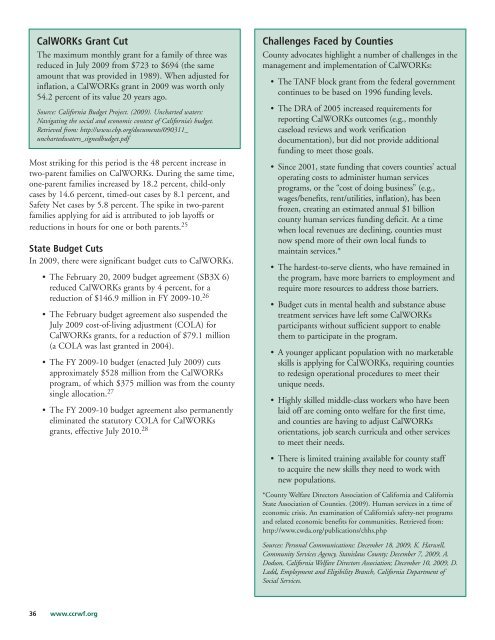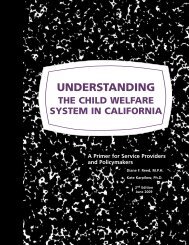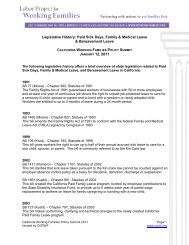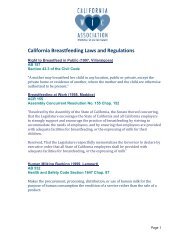Understanding CalWORKs - California Center for Research on ...
Understanding CalWORKs - California Center for Research on ...
Understanding CalWORKs - California Center for Research on ...
You also want an ePaper? Increase the reach of your titles
YUMPU automatically turns print PDFs into web optimized ePapers that Google loves.
<str<strong>on</strong>g>CalWORKs</str<strong>on</strong>g> Grant CutThe maximum m<strong>on</strong>thly grant <str<strong>on</strong>g>for</str<strong>on</strong>g> a family of three wasreduced in July 2009 from $723 to $694 (the sameamount that was provided in 1989). When adjusted <str<strong>on</strong>g>for</str<strong>on</strong>g>inflati<strong>on</strong>, a <str<strong>on</strong>g>CalWORKs</str<strong>on</strong>g> grant in 2009 was worth <strong>on</strong>ly54.2 percent of its value 20 years ago.Source: <str<strong>on</strong>g>Cali<str<strong>on</strong>g>for</str<strong>on</strong>g>nia</str<strong>on</strong>g> Budget Project. (2009). Uncharted waters:Navigating the social and ec<strong>on</strong>omic c<strong>on</strong>text of <str<strong>on</strong>g>Cali<str<strong>on</strong>g>for</str<strong>on</strong>g>nia</str<strong>on</strong>g>’s budget.Retrieved from: http://www.cbp.org/documents/090311_unchartedwaters_signedbudget.pdfMost striking <str<strong>on</strong>g>for</str<strong>on</strong>g> this period is the 48 percent increase intwo-parent families <strong>on</strong> <str<strong>on</strong>g>CalWORKs</str<strong>on</strong>g>. During the same time,<strong>on</strong>e-parent families increased by 18.2 percent, child-<strong>on</strong>lycases by 14.6 percent, timed-out cases by 8.1 percent, andSafety Net cases by 5.8 percent. The spike in two-parentfamilies applying <str<strong>on</strong>g>for</str<strong>on</strong>g> aid is attributed to job layoffs orreducti<strong>on</strong>s in hours <str<strong>on</strong>g>for</str<strong>on</strong>g> <strong>on</strong>e or both parents. 25State Budget CutsIn 2009, there were significant budget cuts to <str<strong>on</strong>g>CalWORKs</str<strong>on</strong>g>.• The February 20, 2009 budget agreement (SB3X 6)reduced <str<strong>on</strong>g>CalWORKs</str<strong>on</strong>g> grants by 4 percent, <str<strong>on</strong>g>for</str<strong>on</strong>g> areducti<strong>on</strong> of $146.9 milli<strong>on</strong> in FY 2009-10. 26• The February budget agreement also suspended theJuly 2009 cost-of-living adjustment (COLA) <str<strong>on</strong>g>for</str<strong>on</strong>g><str<strong>on</strong>g>CalWORKs</str<strong>on</strong>g> grants, <str<strong>on</strong>g>for</str<strong>on</strong>g> a reducti<strong>on</strong> of $79.1 milli<strong>on</strong>(a COLA was last granted in 2004).• The FY 2009-10 budget (enacted July 2009) cutsapproximately $528 milli<strong>on</strong> from the <str<strong>on</strong>g>CalWORKs</str<strong>on</strong>g>program, of which $375 milli<strong>on</strong> was from the countysingle allocati<strong>on</strong>. 27• The FY 2009-10 budget agreement also permanentlyeliminated the statutory COLA <str<strong>on</strong>g>for</str<strong>on</strong>g> <str<strong>on</strong>g>CalWORKs</str<strong>on</strong>g>grants, effective July 2010. 28Challenges Faced by CountiesCounty advocates highlight a number of challenges in themanagement and implementati<strong>on</strong> of <str<strong>on</strong>g>CalWORKs</str<strong>on</strong>g>:• The TANF block grant from the federal governmentc<strong>on</strong>tinues to be based <strong>on</strong> 1996 funding levels.• The DRA of 2005 increased requirements <str<strong>on</strong>g>for</str<strong>on</strong>g>reporting <str<strong>on</strong>g>CalWORKs</str<strong>on</strong>g> outcomes (e.g., m<strong>on</strong>thlycaseload reviews and work verificati<strong>on</strong>documentati<strong>on</strong>), but did not provide additi<strong>on</strong>alfunding to meet those goals.• Since 2001, state funding that covers counties’ actualoperating costs to administer human servicesprograms, or the “cost of doing business” (e.g.,wages/benefits, rent/utilities, inflati<strong>on</strong>), has beenfrozen, creating an estimated annual $1 billi<strong>on</strong>county human services funding deficit. At a timewhen local revenues are declining, counties mustnow spend more of their own local funds tomaintain services.*• The hardest-to-serve clients, who have remained inthe program, have more barriers to employment andrequire more resources to address those barriers.• Budget cuts in mental health and substance abusetreatment services have left some <str<strong>on</strong>g>CalWORKs</str<strong>on</strong>g>participants without sufficient support to enablethem to participate in the program.• A younger applicant populati<strong>on</strong> with no marketableskills is applying <str<strong>on</strong>g>for</str<strong>on</strong>g> <str<strong>on</strong>g>CalWORKs</str<strong>on</strong>g>, requiring countiesto redesign operati<strong>on</strong>al procedures to meet theirunique needs.• Highly skilled middle-class workers who have beenlaid off are coming <strong>on</strong>to welfare <str<strong>on</strong>g>for</str<strong>on</strong>g> the first time,and counties are having to adjust <str<strong>on</strong>g>CalWORKs</str<strong>on</strong>g>orientati<strong>on</strong>s, job search curricula and other servicesto meet their needs.• There is limited training available <str<strong>on</strong>g>for</str<strong>on</strong>g> county staffto acquire the new skills they need to work withnew populati<strong>on</strong>s.*County Welfare Directors Associati<strong>on</strong> of <str<strong>on</strong>g>Cali<str<strong>on</strong>g>for</str<strong>on</strong>g>nia</str<strong>on</strong>g> and <str<strong>on</strong>g>Cali<str<strong>on</strong>g>for</str<strong>on</strong>g>nia</str<strong>on</strong>g>State Associati<strong>on</strong> of Counties. (2009). Human services in a time ofec<strong>on</strong>omic crisis. An examinati<strong>on</strong> of <str<strong>on</strong>g>Cali<str<strong>on</strong>g>for</str<strong>on</strong>g>nia</str<strong>on</strong>g>’s safety-net programsand related ec<strong>on</strong>omic benefits <str<strong>on</strong>g>for</str<strong>on</strong>g> communities. Retrieved from:http://www.cwda.org/publicati<strong>on</strong>s/chhs.phpSources: Pers<strong>on</strong>al Communicati<strong>on</strong>s: December 18, 2009, K. Harwell,Community Services Agency, Stanislaus County; December 7, 2009, A.Dods<strong>on</strong>, <str<strong>on</strong>g>Cali<str<strong>on</strong>g>for</str<strong>on</strong>g>nia</str<strong>on</strong>g> Welfare Directors Associati<strong>on</strong>; December 10, 2009, D.Ladd, Employment and Eligibility Branch, <str<strong>on</strong>g>Cali<str<strong>on</strong>g>for</str<strong>on</strong>g>nia</str<strong>on</strong>g> Department ofSocial Services.36 www.ccrwf.org










